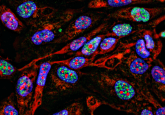Nanobiosensor developed to assist in cancer detection

Researchers from Syracuse University (NY, USA) have created tiny sensors that can detect, characterize and analyze protein–protein interactions in blood serum. This novel class of nanomaterial could be used to assist in cancer detection by identifying and targeting proteins that allow cancerous cells to grow and spread in real-time.
The study, published in Nature Biotechnology, details the development and optimization of the unique class of biophysical tools, termed nanobiosensors, developed in Liviu Movileanu’s lab (Syracuse University). These are highly sensitive, pore-based tools able to detect protein–protein interactions at the single-molecule level.
The nanobiosensors work by shooting an electric current through a nanopore in the cell membrane, which becomes more or less intense as proteins pass or travel through the hole, enabling them to be identified.
“Detailed knowledge of the human genome has opened up a new frontier for the identification of many functional proteins involved in brief physical associations with other proteins,” explains Movileanu, Syracuse University. “Major perturbations in the strength of these PPIs lead to disease conditions. Because of the transient nature of these interactions, new methods are needed to assess them.”
Movileanu is particularly interested in lymphocytic leukemia since cells do not mature and die properly, and can often be out of control. Movileanu commented: “Leukemia cells build up in the bone marrow and crowd out normal, healthy cells. Unlike other cancers, which usually start in the breasts, colon or lungs, lymphocytic leukemia originates in the lymph nodes, hence the name.”
“The data gleaned from a single protein sample is immense. Our nanostructures allow us to observe biochemical events in a sensitive, specific and quantitative manner. Afterward, we can make a solid assessment about a single protein sample.”
In the future, Movileanu and his team hope to study protein–protein interactions in more complex biological samples, such as cell lysates and tissue biopsies.
Movileanu concluded: “If we know how individual parts of a cell function, we can figure out why a cell deviates from normal functionality toward a tumor-like state. Our little sensors may do big things for biomarker screening, protein profiling and the large-scale study of proteins.”
Sources: Thakur AK & Movileanu L. Real-time measurement of protein–protein interactions at single-molecule resolution using a biological nanopore. Nat. Biotechnol. https://doi.org/10.1038/nbt.4316 (2018) (Epub ahead of print); www.eurekalert.org/pub_releases/2018-12/su-spc120618.php





